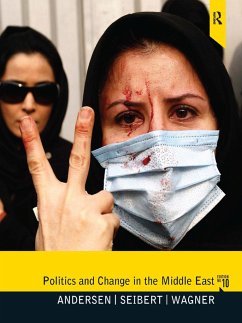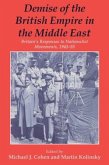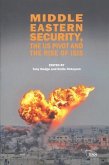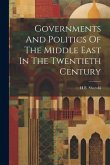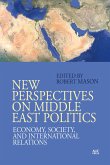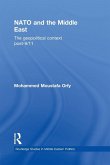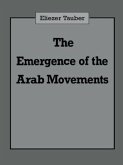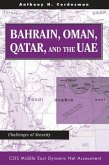- Broschiertes Buch
- Merkliste
- Auf die Merkliste
- Bewerten Bewerten
- Teilen
- Produkt teilen
- Produkterinnerung
- Produkterinnerung
A longtime bestseller, Politics and Change in the Middle East employs a multidisciplinary approach to comprehensively and evenhandedly study the region's past, present, and future. Through politics, economics, culture, and history, this text offers a rugged analytical framework that familiarizes students with the Middle East.
Andere Kunden interessierten sich auch für
![Demise of the British Empire in the Middle East Demise of the British Empire in the Middle East]() Demise of the British Empire in the Middle East99,99 €
Demise of the British Empire in the Middle East99,99 €![Middle Eastern Security, the Us Pivot and the Rise of Isis Middle Eastern Security, the Us Pivot and the Rise of Isis]() Middle Eastern Security, the Us Pivot and the Rise of Isis37,99 €
Middle Eastern Security, the Us Pivot and the Rise of Isis37,99 €![Governments And Politics Of The Middle East In The Twentieth Century Governments And Politics Of The Middle East In The Twentieth Century]() Governments And Politics Of The Middle East In The Twentieth Century26,99 €
Governments And Politics Of The Middle East In The Twentieth Century26,99 €![New Perspectives on Middle East Politics New Perspectives on Middle East Politics]() New Perspectives on Middle East Politics36,99 €
New Perspectives on Middle East Politics36,99 €![NATO and the Middle East NATO and the Middle East]() Mohammed Moustafa OrfyNATO and the Middle East68,99 €
Mohammed Moustafa OrfyNATO and the Middle East68,99 €![The Emergence of the Arab Movements The Emergence of the Arab Movements]() Eliezer TauberThe Emergence of the Arab Movements92,99 €
Eliezer TauberThe Emergence of the Arab Movements92,99 €![Bahrain, Oman, Qatar, And The Uae Bahrain, Oman, Qatar, And The Uae]() Anthony H CordesmanBahrain, Oman, Qatar, And The Uae80,99 €
Anthony H CordesmanBahrain, Oman, Qatar, And The Uae80,99 €-
-
-
A longtime bestseller, Politics and Change in the Middle East employs a multidisciplinary approach to comprehensively and evenhandedly study the region's past, present, and future. Through politics, economics, culture, and history, this text offers a rugged analytical framework that familiarizes students with the Middle East.
Hinweis: Dieser Artikel kann nur an eine deutsche Lieferadresse ausgeliefert werden.
Hinweis: Dieser Artikel kann nur an eine deutsche Lieferadresse ausgeliefert werden.
Produktdetails
- Produktdetails
- Verlag: Taylor & Francis
- 10th Revised edition
- Seitenzahl: 432
- Erscheinungstermin: 27. Februar 2011
- Englisch
- Abmessung: 229mm x 185mm x 30mm
- Gewicht: 676g
- ISBN-13: 9780205082391
- ISBN-10: 0205082394
- Artikelnr.: 33139952
- Herstellerkennzeichnung
- Libri GmbH
- Europaallee 1
- 36244 Bad Hersfeld
- gpsr@libri.de
- Verlag: Taylor & Francis
- 10th Revised edition
- Seitenzahl: 432
- Erscheinungstermin: 27. Februar 2011
- Englisch
- Abmessung: 229mm x 185mm x 30mm
- Gewicht: 676g
- ISBN-13: 9780205082391
- ISBN-10: 0205082394
- Artikelnr.: 33139952
- Herstellerkennzeichnung
- Libri GmbH
- Europaallee 1
- 36244 Bad Hersfeld
- gpsr@libri.de
Roy R. Anderson
Detailed Contents
Introduction
Chapter 1 Traditional Cultures of the Middle East: The
of Civilization and Politics
Chapter 2 The Foundations of Islam
Chapter 3 The Political Legacy of Islam, 632
1800 C.E.
Chapter 4 Western Imperialism, 1800
1914 C.E.
Chapter 5 The Rise of the State System, 1914
1950
Chapter 6 The Drive for Self
Determination, 1950
1990
Chapter 7 Turning Points
Chapter 8 The Politics of Religion, Culture, and Social Life
Chapter 9 Political Elites
Chapter 10 Political Leadership in the Contemporary East
Chapter 11 The Economic Setting
Chapter 12 International Relations in the Middle
1945
1990
Chapter 13 International Relations in the Middle
1945
1990: The Regional Actors
Chapter 14 The Middle East and the Changing
Order: 1991
2001
Chapter 15 Did 9 /11 Change Everything?
Glossary
Index. Preface
BRIEF CONTENTS
INTRODUCTION
Politics and Conflict
Approaches to Social Change
Chapter 1 TRADITIONAL CULTURES OF THE MIDDLE
THE CRADLE OF CIVILIZATION AND POLITICS
Foundations of Social Diversity
Ecological Diversity
Nomads
Peasants and Urbanites
Ethnic and Religious Diversity
Descent, Occupation, and Social Stratification
The Patchwork of Pluralism: Two Historical Examples
Unity in Diversity
Family, Kinship, and Marriage
Religion
Chapter 2 THE FOUNDATIONS OF ISLAM
Central Beliefs of Islam
The Five Pillars of Islam
The Koran and the Hadith
The Ulema
Pre
Islamic Arab Ethics
The Social Setting of Mecca
The Confessional Religions
Muhammad's Ministry
The Hijira
The Koran's Social Regulations
The Spread of Islam
Jihad and the Djimmi System
Five Popular Misconceptions about Islam
Islam as an Exotic Religion
Islam as a Militant Religion
Islam as an Intolerant Religion
Islam as an Ultraconservative Religion
Islam as a Sexist Religion
Conclusion
Chapter 3 THE POLITICAL LEGACY OF
632
1800 C.E.
The Establishment of the Islamic State
The Golden Age of the Caliphate
Mongol Destruction and the Rebirth of the Empire
The Ottoman Empire
Growth and Decline in the Islamic State
Legitimacy in Government
The Political Role of the Ulema
The Sharia Law
The Shia
Sufism
Islam and Radical Politics
The Kharijites
Ismailis and Qarmatians
The Mahdi
Twelver Shiism
The Muwahhidun Movement
Diversity in Islamic Political Thought
Chapter 4 WESTERN IMPERIALISM, 1800
1914 C.E.
Setting the Stage
The Ottomans
Tanzimat Period (1839
1876)
Egypt
The Levant
The Arabian Peninsula
Iran
Qajar Dynasty
Conclusion
Chapter 5 THE RISE OF THE STATE SYSTEM, 1914
1950
The McMahon
Husein Correspondence
The Balfour Declaration
World Zionist Organization
The Mandates
Syria and Lebanon
Iraq and Transjordan
Egypt
Wafd Party and Muslim Brotherhood
Egypt after World War II
Saudi Arabia
Turkey and Iran
Turkey
Iran
From Palestine to Israel
Conclusion
Chapter 6 THE DRIVE FOR
1950
1990
Arab Nationalism
Suez Canal Crisis and the Israeli War (1956)
Syria
The United Arab Republic
Jordan, Lebanon, and Iraq
Iran, the Gulf States, and Petroleum
Iranian Revolution
Iranian Revolutionary Government
Iraq
Iran War: 1980
1988
Saudi Arabia's Political Stability
Yemen
Gulf Cooperation Council
Israel
Political Setting
Social Setting
Israel and the Border States
The 1956 Arab
Israeli War
The 1967 Arab
Israeli War
The 1973 Arab
Israeli War
The 1982 Invasion of Lebanon
The Palestinians and the 1988 Uprising
The First Intifadah
Conclusion
Chapter 7 TURNING POINTS
Circa 1990
Circa 2000
Circa 2010
Globalization
Arab Nationalism
International Organizations
Economic Liberalization
Political Islam
Occupation of Iraq
Political Legitimacy in the Gulf
From Oslo to Jerusalem to Gaza
Conclusion
Chapter 8 THE POLITICS OF RELIGION,
AND SOCIAL LIFE
The Politics of Culture
Politics of Culture in Islamic History
Colonialism and Cultural Politics
The Contemporary Politics of Islam
Turkey: Radical Westernization and the Durability of Islam
Egypt: The Labyrinth of Possibilities
Saudi Arabia
Iran and the Islamic Republic
The Islamic Republic
Sexual Politics
Sexual Equality in Islam: The Modernist Interpretation
Sexual Inequality in Islamic Tradition
Struggle for Reform
Women in the Islamic Revival
Conclusion
Chapter 9 POLITICAL ELITES
Traditional, Transitional, and Technically Modernizing Elites
Traditional Elites
Transitional Elites
IRAN
SAUDI ARABIA
KUWAIT
BAHRAIN
LIBYA
JORDAN
GULF EMIRATES
Modern Elites
TURKEY
EGYPT
SYRIA
IRAQ
LEBANON
ISRAEL
Conclusion
Chapter 10 POLITICAL LEADERSHIP IN THE
MIDDLE EAST
Traditional Leadership
King Farouk of Egypt
Charismatic Leadership
Gamal Abdel Nasser
Modern Bureaucratic Leadership
Anwar Sadat and Hosni Mubarak
Consequences of Leadership Styles
Traditional States
Modern Bureaucratic States
Charismatic Rule
Ayatollah Ruhollah Khomeini
Colonel Muammar Qadaffi
Conclusion
Chapter 11 THE ECONOMIC SETTING
Economic Record
Organization of Economic Activity
Islamic Economics
Economic Liberalization
TURKEY
IRAN
Liberalization and Globalization
Land Distribution Policies
Turkey
Egypt
Syria
Libya, Iraq, and Iran
Agricultural Policies
Water
Population
Migration
Urbanization
Employment
Industry
Petroleum
Early Years
World War II to 1970
OPEC Revolution
Conclusion
Chapter 12 INTERNATIONAL RELATIONS IN THE MIDDLE
1945
1990
The Great
Power System and The Middle East
U.S. Foreign Policy
Phase I
Phase II
INTERVENTIONS IN IRAN
SUEZ WAR
LEBANON CRISIS OF 1958
Phase III
Soviet Foreign Policy
Britain and France
China and Japan
Conclusion
Chapter 13 INTERNATIONAL RELATIONS IN THE MIDDLE
1945
1990: THE REGIONAL ACTORS
Palestinian International Action
OPEC and Islam
Nuclear Arms and Regional Politics
Foreign Policies of Egypt, Saudi Arabia, Iran, and Israel
Egyptian Foreign Policy
EGYPTIAN FOREIGN POLICY UNDER SADAT AND MUBARAK
Saudi Arabian Foreign Policy
Iranian Foreign Policy
FOREIGN POLICY OF THE IRANIAN REVOLUTION
Israeli Foreign Policy
Conclusion
Chapter 14 THE MIDDLE EAST AND THE
INTERNATIONAL ORDER: 1991
2001
Dimensions of the Emerging International Order
The Middle East in the Emerging International Order
Iraq
Kuwait Crisis
Multinational Actors in the Conflict
Desert Storm
The Middle East at the End of Desert Storm
Desert Storm as Indicator of New
Realities
The Arabs and the Israelis
From Jerusalem to Oslo
Superpowers and Great Powers
Middle Eastern States
Egypt
Saudi Arabia
Other Gulf States
Syria
Lebanon
Iran
Turkey
Algeria, Morocco, and Tunisia
Libya
Israel
Conclusion
The View from 2000
Chapter 15 DID 9 /11 CHANGE EVERYTHING?
The Reemergence of Iraq
Two Coalitions
The Middle East Quartet
Regional Actors
World Public Opinion
War
Perceptions
A New Decade
Elections in Israel
Elections in Iran
Elections in Iraq
Regional Politics
Turkey
Saudi Arabia
GCC
Egypt
Syria
Jordan
Iraq
A Clash of Civilizations?
Conclusion
Glossary
Index
Introduction
Chapter 1 Traditional Cultures of the Middle East: The
of Civilization and Politics
Chapter 2 The Foundations of Islam
Chapter 3 The Political Legacy of Islam, 632
1800 C.E.
Chapter 4 Western Imperialism, 1800
1914 C.E.
Chapter 5 The Rise of the State System, 1914
1950
Chapter 6 The Drive for Self
Determination, 1950
1990
Chapter 7 Turning Points
Chapter 8 The Politics of Religion, Culture, and Social Life
Chapter 9 Political Elites
Chapter 10 Political Leadership in the Contemporary East
Chapter 11 The Economic Setting
Chapter 12 International Relations in the Middle
1945
1990
Chapter 13 International Relations in the Middle
1945
1990: The Regional Actors
Chapter 14 The Middle East and the Changing
Order: 1991
2001
Chapter 15 Did 9 /11 Change Everything?
Glossary
Index. Preface
BRIEF CONTENTS
INTRODUCTION
Politics and Conflict
Approaches to Social Change
Chapter 1 TRADITIONAL CULTURES OF THE MIDDLE
THE CRADLE OF CIVILIZATION AND POLITICS
Foundations of Social Diversity
Ecological Diversity
Nomads
Peasants and Urbanites
Ethnic and Religious Diversity
Descent, Occupation, and Social Stratification
The Patchwork of Pluralism: Two Historical Examples
Unity in Diversity
Family, Kinship, and Marriage
Religion
Chapter 2 THE FOUNDATIONS OF ISLAM
Central Beliefs of Islam
The Five Pillars of Islam
The Koran and the Hadith
The Ulema
Pre
Islamic Arab Ethics
The Social Setting of Mecca
The Confessional Religions
Muhammad's Ministry
The Hijira
The Koran's Social Regulations
The Spread of Islam
Jihad and the Djimmi System
Five Popular Misconceptions about Islam
Islam as an Exotic Religion
Islam as a Militant Religion
Islam as an Intolerant Religion
Islam as an Ultraconservative Religion
Islam as a Sexist Religion
Conclusion
Chapter 3 THE POLITICAL LEGACY OF
632
1800 C.E.
The Establishment of the Islamic State
The Golden Age of the Caliphate
Mongol Destruction and the Rebirth of the Empire
The Ottoman Empire
Growth and Decline in the Islamic State
Legitimacy in Government
The Political Role of the Ulema
The Sharia Law
The Shia
Sufism
Islam and Radical Politics
The Kharijites
Ismailis and Qarmatians
The Mahdi
Twelver Shiism
The Muwahhidun Movement
Diversity in Islamic Political Thought
Chapter 4 WESTERN IMPERIALISM, 1800
1914 C.E.
Setting the Stage
The Ottomans
Tanzimat Period (1839
1876)
Egypt
The Levant
The Arabian Peninsula
Iran
Qajar Dynasty
Conclusion
Chapter 5 THE RISE OF THE STATE SYSTEM, 1914
1950
The McMahon
Husein Correspondence
The Balfour Declaration
World Zionist Organization
The Mandates
Syria and Lebanon
Iraq and Transjordan
Egypt
Wafd Party and Muslim Brotherhood
Egypt after World War II
Saudi Arabia
Turkey and Iran
Turkey
Iran
From Palestine to Israel
Conclusion
Chapter 6 THE DRIVE FOR
1950
1990
Arab Nationalism
Suez Canal Crisis and the Israeli War (1956)
Syria
The United Arab Republic
Jordan, Lebanon, and Iraq
Iran, the Gulf States, and Petroleum
Iranian Revolution
Iranian Revolutionary Government
Iraq
Iran War: 1980
1988
Saudi Arabia's Political Stability
Yemen
Gulf Cooperation Council
Israel
Political Setting
Social Setting
Israel and the Border States
The 1956 Arab
Israeli War
The 1967 Arab
Israeli War
The 1973 Arab
Israeli War
The 1982 Invasion of Lebanon
The Palestinians and the 1988 Uprising
The First Intifadah
Conclusion
Chapter 7 TURNING POINTS
Circa 1990
Circa 2000
Circa 2010
Globalization
Arab Nationalism
International Organizations
Economic Liberalization
Political Islam
Occupation of Iraq
Political Legitimacy in the Gulf
From Oslo to Jerusalem to Gaza
Conclusion
Chapter 8 THE POLITICS OF RELIGION,
AND SOCIAL LIFE
The Politics of Culture
Politics of Culture in Islamic History
Colonialism and Cultural Politics
The Contemporary Politics of Islam
Turkey: Radical Westernization and the Durability of Islam
Egypt: The Labyrinth of Possibilities
Saudi Arabia
Iran and the Islamic Republic
The Islamic Republic
Sexual Politics
Sexual Equality in Islam: The Modernist Interpretation
Sexual Inequality in Islamic Tradition
Struggle for Reform
Women in the Islamic Revival
Conclusion
Chapter 9 POLITICAL ELITES
Traditional, Transitional, and Technically Modernizing Elites
Traditional Elites
Transitional Elites
IRAN
SAUDI ARABIA
KUWAIT
BAHRAIN
LIBYA
JORDAN
GULF EMIRATES
Modern Elites
TURKEY
EGYPT
SYRIA
IRAQ
LEBANON
ISRAEL
Conclusion
Chapter 10 POLITICAL LEADERSHIP IN THE
MIDDLE EAST
Traditional Leadership
King Farouk of Egypt
Charismatic Leadership
Gamal Abdel Nasser
Modern Bureaucratic Leadership
Anwar Sadat and Hosni Mubarak
Consequences of Leadership Styles
Traditional States
Modern Bureaucratic States
Charismatic Rule
Ayatollah Ruhollah Khomeini
Colonel Muammar Qadaffi
Conclusion
Chapter 11 THE ECONOMIC SETTING
Economic Record
Organization of Economic Activity
Islamic Economics
Economic Liberalization
TURKEY
IRAN
Liberalization and Globalization
Land Distribution Policies
Turkey
Egypt
Syria
Libya, Iraq, and Iran
Agricultural Policies
Water
Population
Migration
Urbanization
Employment
Industry
Petroleum
Early Years
World War II to 1970
OPEC Revolution
Conclusion
Chapter 12 INTERNATIONAL RELATIONS IN THE MIDDLE
1945
1990
The Great
Power System and The Middle East
U.S. Foreign Policy
Phase I
Phase II
INTERVENTIONS IN IRAN
SUEZ WAR
LEBANON CRISIS OF 1958
Phase III
Soviet Foreign Policy
Britain and France
China and Japan
Conclusion
Chapter 13 INTERNATIONAL RELATIONS IN THE MIDDLE
1945
1990: THE REGIONAL ACTORS
Palestinian International Action
OPEC and Islam
Nuclear Arms and Regional Politics
Foreign Policies of Egypt, Saudi Arabia, Iran, and Israel
Egyptian Foreign Policy
EGYPTIAN FOREIGN POLICY UNDER SADAT AND MUBARAK
Saudi Arabian Foreign Policy
Iranian Foreign Policy
FOREIGN POLICY OF THE IRANIAN REVOLUTION
Israeli Foreign Policy
Conclusion
Chapter 14 THE MIDDLE EAST AND THE
INTERNATIONAL ORDER: 1991
2001
Dimensions of the Emerging International Order
The Middle East in the Emerging International Order
Iraq
Kuwait Crisis
Multinational Actors in the Conflict
Desert Storm
The Middle East at the End of Desert Storm
Desert Storm as Indicator of New
Realities
The Arabs and the Israelis
From Jerusalem to Oslo
Superpowers and Great Powers
Middle Eastern States
Egypt
Saudi Arabia
Other Gulf States
Syria
Lebanon
Iran
Turkey
Algeria, Morocco, and Tunisia
Libya
Israel
Conclusion
The View from 2000
Chapter 15 DID 9 /11 CHANGE EVERYTHING?
The Reemergence of Iraq
Two Coalitions
The Middle East Quartet
Regional Actors
World Public Opinion
War
Perceptions
A New Decade
Elections in Israel
Elections in Iran
Elections in Iraq
Regional Politics
Turkey
Saudi Arabia
GCC
Egypt
Syria
Jordan
Iraq
A Clash of Civilizations?
Conclusion
Glossary
Index
Detailed Contents
Introduction
Chapter 1 Traditional Cultures of the Middle East: The
of Civilization and Politics
Chapter 2 The Foundations of Islam
Chapter 3 The Political Legacy of Islam, 632
1800 C.E.
Chapter 4 Western Imperialism, 1800
1914 C.E.
Chapter 5 The Rise of the State System, 1914
1950
Chapter 6 The Drive for Self
Determination, 1950
1990
Chapter 7 Turning Points
Chapter 8 The Politics of Religion, Culture, and Social Life
Chapter 9 Political Elites
Chapter 10 Political Leadership in the Contemporary East
Chapter 11 The Economic Setting
Chapter 12 International Relations in the Middle
1945
1990
Chapter 13 International Relations in the Middle
1945
1990: The Regional Actors
Chapter 14 The Middle East and the Changing
Order: 1991
2001
Chapter 15 Did 9 /11 Change Everything?
Glossary
Index. Preface
BRIEF CONTENTS
INTRODUCTION
Politics and Conflict
Approaches to Social Change
Chapter 1 TRADITIONAL CULTURES OF THE MIDDLE
THE CRADLE OF CIVILIZATION AND POLITICS
Foundations of Social Diversity
Ecological Diversity
Nomads
Peasants and Urbanites
Ethnic and Religious Diversity
Descent, Occupation, and Social Stratification
The Patchwork of Pluralism: Two Historical Examples
Unity in Diversity
Family, Kinship, and Marriage
Religion
Chapter 2 THE FOUNDATIONS OF ISLAM
Central Beliefs of Islam
The Five Pillars of Islam
The Koran and the Hadith
The Ulema
Pre
Islamic Arab Ethics
The Social Setting of Mecca
The Confessional Religions
Muhammad's Ministry
The Hijira
The Koran's Social Regulations
The Spread of Islam
Jihad and the Djimmi System
Five Popular Misconceptions about Islam
Islam as an Exotic Religion
Islam as a Militant Religion
Islam as an Intolerant Religion
Islam as an Ultraconservative Religion
Islam as a Sexist Religion
Conclusion
Chapter 3 THE POLITICAL LEGACY OF
632
1800 C.E.
The Establishment of the Islamic State
The Golden Age of the Caliphate
Mongol Destruction and the Rebirth of the Empire
The Ottoman Empire
Growth and Decline in the Islamic State
Legitimacy in Government
The Political Role of the Ulema
The Sharia Law
The Shia
Sufism
Islam and Radical Politics
The Kharijites
Ismailis and Qarmatians
The Mahdi
Twelver Shiism
The Muwahhidun Movement
Diversity in Islamic Political Thought
Chapter 4 WESTERN IMPERIALISM, 1800
1914 C.E.
Setting the Stage
The Ottomans
Tanzimat Period (1839
1876)
Egypt
The Levant
The Arabian Peninsula
Iran
Qajar Dynasty
Conclusion
Chapter 5 THE RISE OF THE STATE SYSTEM, 1914
1950
The McMahon
Husein Correspondence
The Balfour Declaration
World Zionist Organization
The Mandates
Syria and Lebanon
Iraq and Transjordan
Egypt
Wafd Party and Muslim Brotherhood
Egypt after World War II
Saudi Arabia
Turkey and Iran
Turkey
Iran
From Palestine to Israel
Conclusion
Chapter 6 THE DRIVE FOR
1950
1990
Arab Nationalism
Suez Canal Crisis and the Israeli War (1956)
Syria
The United Arab Republic
Jordan, Lebanon, and Iraq
Iran, the Gulf States, and Petroleum
Iranian Revolution
Iranian Revolutionary Government
Iraq
Iran War: 1980
1988
Saudi Arabia's Political Stability
Yemen
Gulf Cooperation Council
Israel
Political Setting
Social Setting
Israel and the Border States
The 1956 Arab
Israeli War
The 1967 Arab
Israeli War
The 1973 Arab
Israeli War
The 1982 Invasion of Lebanon
The Palestinians and the 1988 Uprising
The First Intifadah
Conclusion
Chapter 7 TURNING POINTS
Circa 1990
Circa 2000
Circa 2010
Globalization
Arab Nationalism
International Organizations
Economic Liberalization
Political Islam
Occupation of Iraq
Political Legitimacy in the Gulf
From Oslo to Jerusalem to Gaza
Conclusion
Chapter 8 THE POLITICS OF RELIGION,
AND SOCIAL LIFE
The Politics of Culture
Politics of Culture in Islamic History
Colonialism and Cultural Politics
The Contemporary Politics of Islam
Turkey: Radical Westernization and the Durability of Islam
Egypt: The Labyrinth of Possibilities
Saudi Arabia
Iran and the Islamic Republic
The Islamic Republic
Sexual Politics
Sexual Equality in Islam: The Modernist Interpretation
Sexual Inequality in Islamic Tradition
Struggle for Reform
Women in the Islamic Revival
Conclusion
Chapter 9 POLITICAL ELITES
Traditional, Transitional, and Technically Modernizing Elites
Traditional Elites
Transitional Elites
IRAN
SAUDI ARABIA
KUWAIT
BAHRAIN
LIBYA
JORDAN
GULF EMIRATES
Modern Elites
TURKEY
EGYPT
SYRIA
IRAQ
LEBANON
ISRAEL
Conclusion
Chapter 10 POLITICAL LEADERSHIP IN THE
MIDDLE EAST
Traditional Leadership
King Farouk of Egypt
Charismatic Leadership
Gamal Abdel Nasser
Modern Bureaucratic Leadership
Anwar Sadat and Hosni Mubarak
Consequences of Leadership Styles
Traditional States
Modern Bureaucratic States
Charismatic Rule
Ayatollah Ruhollah Khomeini
Colonel Muammar Qadaffi
Conclusion
Chapter 11 THE ECONOMIC SETTING
Economic Record
Organization of Economic Activity
Islamic Economics
Economic Liberalization
TURKEY
IRAN
Liberalization and Globalization
Land Distribution Policies
Turkey
Egypt
Syria
Libya, Iraq, and Iran
Agricultural Policies
Water
Population
Migration
Urbanization
Employment
Industry
Petroleum
Early Years
World War II to 1970
OPEC Revolution
Conclusion
Chapter 12 INTERNATIONAL RELATIONS IN THE MIDDLE
1945
1990
The Great
Power System and The Middle East
U.S. Foreign Policy
Phase I
Phase II
INTERVENTIONS IN IRAN
SUEZ WAR
LEBANON CRISIS OF 1958
Phase III
Soviet Foreign Policy
Britain and France
China and Japan
Conclusion
Chapter 13 INTERNATIONAL RELATIONS IN THE MIDDLE
1945
1990: THE REGIONAL ACTORS
Palestinian International Action
OPEC and Islam
Nuclear Arms and Regional Politics
Foreign Policies of Egypt, Saudi Arabia, Iran, and Israel
Egyptian Foreign Policy
EGYPTIAN FOREIGN POLICY UNDER SADAT AND MUBARAK
Saudi Arabian Foreign Policy
Iranian Foreign Policy
FOREIGN POLICY OF THE IRANIAN REVOLUTION
Israeli Foreign Policy
Conclusion
Chapter 14 THE MIDDLE EAST AND THE
INTERNATIONAL ORDER: 1991
2001
Dimensions of the Emerging International Order
The Middle East in the Emerging International Order
Iraq
Kuwait Crisis
Multinational Actors in the Conflict
Desert Storm
The Middle East at the End of Desert Storm
Desert Storm as Indicator of New
Realities
The Arabs and the Israelis
From Jerusalem to Oslo
Superpowers and Great Powers
Middle Eastern States
Egypt
Saudi Arabia
Other Gulf States
Syria
Lebanon
Iran
Turkey
Algeria, Morocco, and Tunisia
Libya
Israel
Conclusion
The View from 2000
Chapter 15 DID 9 /11 CHANGE EVERYTHING?
The Reemergence of Iraq
Two Coalitions
The Middle East Quartet
Regional Actors
World Public Opinion
War
Perceptions
A New Decade
Elections in Israel
Elections in Iran
Elections in Iraq
Regional Politics
Turkey
Saudi Arabia
GCC
Egypt
Syria
Jordan
Iraq
A Clash of Civilizations?
Conclusion
Glossary
Index
Introduction
Chapter 1 Traditional Cultures of the Middle East: The
of Civilization and Politics
Chapter 2 The Foundations of Islam
Chapter 3 The Political Legacy of Islam, 632
1800 C.E.
Chapter 4 Western Imperialism, 1800
1914 C.E.
Chapter 5 The Rise of the State System, 1914
1950
Chapter 6 The Drive for Self
Determination, 1950
1990
Chapter 7 Turning Points
Chapter 8 The Politics of Religion, Culture, and Social Life
Chapter 9 Political Elites
Chapter 10 Political Leadership in the Contemporary East
Chapter 11 The Economic Setting
Chapter 12 International Relations in the Middle
1945
1990
Chapter 13 International Relations in the Middle
1945
1990: The Regional Actors
Chapter 14 The Middle East and the Changing
Order: 1991
2001
Chapter 15 Did 9 /11 Change Everything?
Glossary
Index. Preface
BRIEF CONTENTS
INTRODUCTION
Politics and Conflict
Approaches to Social Change
Chapter 1 TRADITIONAL CULTURES OF THE MIDDLE
THE CRADLE OF CIVILIZATION AND POLITICS
Foundations of Social Diversity
Ecological Diversity
Nomads
Peasants and Urbanites
Ethnic and Religious Diversity
Descent, Occupation, and Social Stratification
The Patchwork of Pluralism: Two Historical Examples
Unity in Diversity
Family, Kinship, and Marriage
Religion
Chapter 2 THE FOUNDATIONS OF ISLAM
Central Beliefs of Islam
The Five Pillars of Islam
The Koran and the Hadith
The Ulema
Pre
Islamic Arab Ethics
The Social Setting of Mecca
The Confessional Religions
Muhammad's Ministry
The Hijira
The Koran's Social Regulations
The Spread of Islam
Jihad and the Djimmi System
Five Popular Misconceptions about Islam
Islam as an Exotic Religion
Islam as a Militant Religion
Islam as an Intolerant Religion
Islam as an Ultraconservative Religion
Islam as a Sexist Religion
Conclusion
Chapter 3 THE POLITICAL LEGACY OF
632
1800 C.E.
The Establishment of the Islamic State
The Golden Age of the Caliphate
Mongol Destruction and the Rebirth of the Empire
The Ottoman Empire
Growth and Decline in the Islamic State
Legitimacy in Government
The Political Role of the Ulema
The Sharia Law
The Shia
Sufism
Islam and Radical Politics
The Kharijites
Ismailis and Qarmatians
The Mahdi
Twelver Shiism
The Muwahhidun Movement
Diversity in Islamic Political Thought
Chapter 4 WESTERN IMPERIALISM, 1800
1914 C.E.
Setting the Stage
The Ottomans
Tanzimat Period (1839
1876)
Egypt
The Levant
The Arabian Peninsula
Iran
Qajar Dynasty
Conclusion
Chapter 5 THE RISE OF THE STATE SYSTEM, 1914
1950
The McMahon
Husein Correspondence
The Balfour Declaration
World Zionist Organization
The Mandates
Syria and Lebanon
Iraq and Transjordan
Egypt
Wafd Party and Muslim Brotherhood
Egypt after World War II
Saudi Arabia
Turkey and Iran
Turkey
Iran
From Palestine to Israel
Conclusion
Chapter 6 THE DRIVE FOR
1950
1990
Arab Nationalism
Suez Canal Crisis and the Israeli War (1956)
Syria
The United Arab Republic
Jordan, Lebanon, and Iraq
Iran, the Gulf States, and Petroleum
Iranian Revolution
Iranian Revolutionary Government
Iraq
Iran War: 1980
1988
Saudi Arabia's Political Stability
Yemen
Gulf Cooperation Council
Israel
Political Setting
Social Setting
Israel and the Border States
The 1956 Arab
Israeli War
The 1967 Arab
Israeli War
The 1973 Arab
Israeli War
The 1982 Invasion of Lebanon
The Palestinians and the 1988 Uprising
The First Intifadah
Conclusion
Chapter 7 TURNING POINTS
Circa 1990
Circa 2000
Circa 2010
Globalization
Arab Nationalism
International Organizations
Economic Liberalization
Political Islam
Occupation of Iraq
Political Legitimacy in the Gulf
From Oslo to Jerusalem to Gaza
Conclusion
Chapter 8 THE POLITICS OF RELIGION,
AND SOCIAL LIFE
The Politics of Culture
Politics of Culture in Islamic History
Colonialism and Cultural Politics
The Contemporary Politics of Islam
Turkey: Radical Westernization and the Durability of Islam
Egypt: The Labyrinth of Possibilities
Saudi Arabia
Iran and the Islamic Republic
The Islamic Republic
Sexual Politics
Sexual Equality in Islam: The Modernist Interpretation
Sexual Inequality in Islamic Tradition
Struggle for Reform
Women in the Islamic Revival
Conclusion
Chapter 9 POLITICAL ELITES
Traditional, Transitional, and Technically Modernizing Elites
Traditional Elites
Transitional Elites
IRAN
SAUDI ARABIA
KUWAIT
BAHRAIN
LIBYA
JORDAN
GULF EMIRATES
Modern Elites
TURKEY
EGYPT
SYRIA
IRAQ
LEBANON
ISRAEL
Conclusion
Chapter 10 POLITICAL LEADERSHIP IN THE
MIDDLE EAST
Traditional Leadership
King Farouk of Egypt
Charismatic Leadership
Gamal Abdel Nasser
Modern Bureaucratic Leadership
Anwar Sadat and Hosni Mubarak
Consequences of Leadership Styles
Traditional States
Modern Bureaucratic States
Charismatic Rule
Ayatollah Ruhollah Khomeini
Colonel Muammar Qadaffi
Conclusion
Chapter 11 THE ECONOMIC SETTING
Economic Record
Organization of Economic Activity
Islamic Economics
Economic Liberalization
TURKEY
IRAN
Liberalization and Globalization
Land Distribution Policies
Turkey
Egypt
Syria
Libya, Iraq, and Iran
Agricultural Policies
Water
Population
Migration
Urbanization
Employment
Industry
Petroleum
Early Years
World War II to 1970
OPEC Revolution
Conclusion
Chapter 12 INTERNATIONAL RELATIONS IN THE MIDDLE
1945
1990
The Great
Power System and The Middle East
U.S. Foreign Policy
Phase I
Phase II
INTERVENTIONS IN IRAN
SUEZ WAR
LEBANON CRISIS OF 1958
Phase III
Soviet Foreign Policy
Britain and France
China and Japan
Conclusion
Chapter 13 INTERNATIONAL RELATIONS IN THE MIDDLE
1945
1990: THE REGIONAL ACTORS
Palestinian International Action
OPEC and Islam
Nuclear Arms and Regional Politics
Foreign Policies of Egypt, Saudi Arabia, Iran, and Israel
Egyptian Foreign Policy
EGYPTIAN FOREIGN POLICY UNDER SADAT AND MUBARAK
Saudi Arabian Foreign Policy
Iranian Foreign Policy
FOREIGN POLICY OF THE IRANIAN REVOLUTION
Israeli Foreign Policy
Conclusion
Chapter 14 THE MIDDLE EAST AND THE
INTERNATIONAL ORDER: 1991
2001
Dimensions of the Emerging International Order
The Middle East in the Emerging International Order
Iraq
Kuwait Crisis
Multinational Actors in the Conflict
Desert Storm
The Middle East at the End of Desert Storm
Desert Storm as Indicator of New
Realities
The Arabs and the Israelis
From Jerusalem to Oslo
Superpowers and Great Powers
Middle Eastern States
Egypt
Saudi Arabia
Other Gulf States
Syria
Lebanon
Iran
Turkey
Algeria, Morocco, and Tunisia
Libya
Israel
Conclusion
The View from 2000
Chapter 15 DID 9 /11 CHANGE EVERYTHING?
The Reemergence of Iraq
Two Coalitions
The Middle East Quartet
Regional Actors
World Public Opinion
War
Perceptions
A New Decade
Elections in Israel
Elections in Iran
Elections in Iraq
Regional Politics
Turkey
Saudi Arabia
GCC
Egypt
Syria
Jordan
Iraq
A Clash of Civilizations?
Conclusion
Glossary
Index

